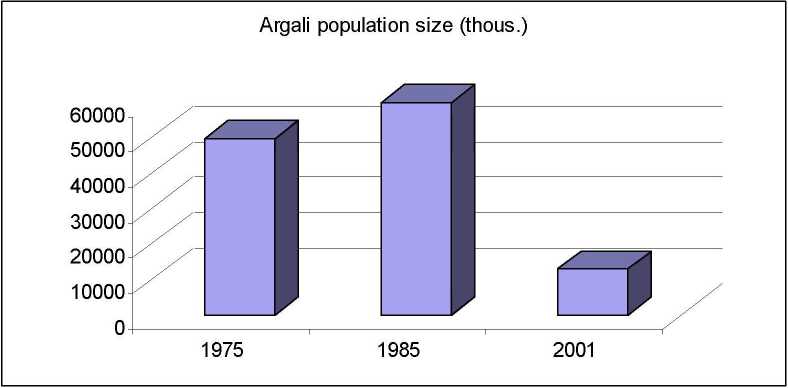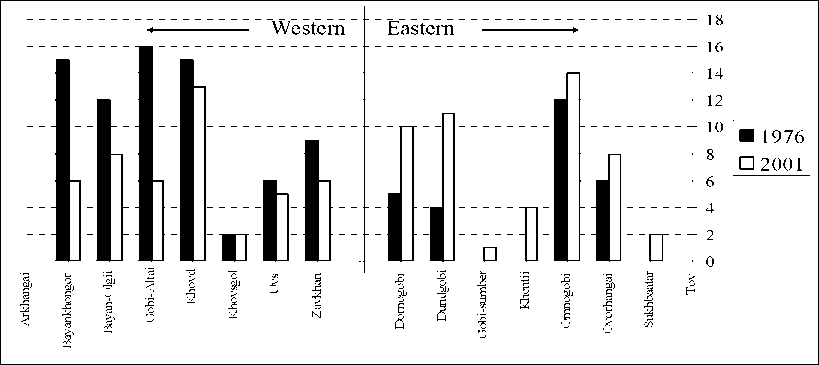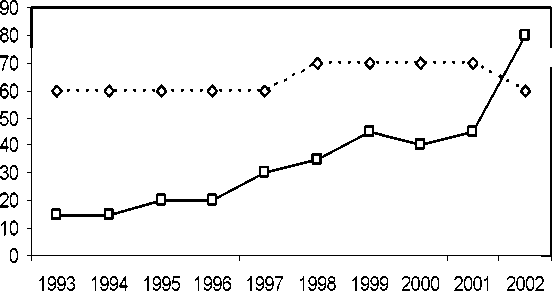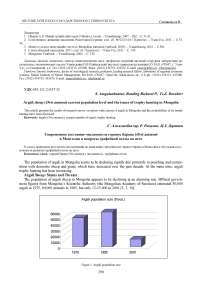Argali sheep (Ovis amnion) current population level and the issues of trophy hunting in Mongolia
Автор: Amgalanbaatar Sukh, Reading Richard P., Dorzhiev Tsydypzhap Zayatuevish
Журнал: Вестник Бурятского государственного университета. Философия @vestnik-bsu
Рубрика: Биология и география
Статья в выпуске: SB, 2012 года.
Бесплатный доступ
This article presents the results of research survey on nation wide census of argali in Mongolia and the availabilities of its trophy hunting have been discussed.
Горный баран (ovis ammon, argali (ovis anmion), current number of argali, trophy hunting
Короткий адрес: https://sciup.org/148181361
IDR: 148181361 | УДК: 639.111.2
Текст научной статьи Argali sheep (Ovis amnion) current population level and the issues of trophy hunting in Mongolia
The population of argali in Mongolia seems to be declining rapidly due primarily to poaching and competition with domestic sheep and goats, which have increased over the past decade. At the same time, argali trophy hunting has been increasing.
Argali Sheep: Status and Threats
The population of argali sheep in Mongolia appears to be declining at an alarming rate. Official government figures from Mongolia's Scientific Authority (the Mongolian Academy of Sciences) estimated 50,000 argali in 1975, 60,000 animals in 1985, but only 13-15,000 in 2001 [5, 7, 10].

Figure 1. Argali population size
The estimated area inhabited by argali declined from about 264,000 km2 in 1985 to about 48,000 km2 in 2001 [7, 9]. We believe the decline in argali numbers is real and have noted the absence of animals from large portions of their former distribution, especially in western Mongolia.
In former core areas of western Mongolia argali population numbers have declined substantially or been locally extirpated, while some populations in eastern Mongolia and the Gobi are faring well and expanding. Throughout the country, the argali distribution is becoming increasingly fragmented.

Figure 2. Argali resource, by aimag
The situation is particularly alarming in western Mongolia. Surveys and interviews with local people in 2001 suggest that argali have been locally extirpated from 35 of 79 Soums (or counties) they formerly inhabited (a 44% decline) in the 8 western-most Aimags [5, 10]. Argali appear to be extirpated from one Aimag, Arkhangai. Alternatively, in eastern and southern Mongolia, argali have re-colonized habitat from which they were extirpated last century. In 2001, argali inhabited 64 Soums in the 8 eastern Aimags up from a mere 29 Soums in 1975. However, some of this increase is likely due to more expansive searches for argali in recent years and the population estimates for these eastern Aimags show a decline from a little over 17,000 argali in 1975 to around 8,500 argali in 2001 [5,10]. As a result of these changes, argali distribution has changed dramatically in recent years. For example, in 1975, about 66% of the argali population lived in the 7 eastern Aimags of the species’ range, but by 2001, that number had to declined to about 46% [5, 10].
The decline of argali is likely the result of several factors; however, we believe that the two most important cause of decline are competition with livestock and poaching.
Argali undoubtedly suffer from competition with livestock, particularly domestic sheep and goats, for limited forage and water [1, 13, 14]. Livestock numbers in Mongolia increased after 1993 when most herds were privatized [1, 16].
The total number of livestock in Mongolia increased from 24.7 million animals in 1989 to 32.9 million in 1998, or an increase of 33.2% [2, 3]. In addition, as the number of livestock increases, herders move their animals into more marginal lands that were traditionally little grazed, often displacing wild ungulates in the process [1, 13, 14]. The western provinces of Mongolia have been particularly affected and even many protected areas now suffer from drastic over-grazing [1, 17].
Poaching is another major and growing cause of argali decline in Mongolia [1, 13]. We have been finding increasing numbers of dead argali without heads. For example in Oshig Mountain, Ovorkhangai Aimag we found 9 dead argali over a 4 day period (some poached, some that died of natural causes) in 2002 that had no heads. Other threats to Mongolia include habitat degradation due to off-road vehicle use, mining operations, and possibly desertification due to global warming. Trophy hunting poses less of a threat, at least given the relatively low recent quotas, but could affect local populations if not well managed.
Alternatively, the presence of trophy hunters could deter poaching and, if funds generated from trophy hunting were used for conservation, the overall impact of well-managed trophy hunting to the harvested population could even be positive [11, 15].
Review of Argali Trophy Hunting in Mongolia
The Mongolian Cabinet sets the number of argali (and all other species) that may be harvested each year by trophy hunters based on recommendations from the Ministry for Nature and Environment (Ministry) [19]. The Ministry, in turn, receives recommendations from local governments [14] and the Mongolian Scientific Authority, which is currently the Institute of Biology of the Mongolian Academy of Sciences. The Institute of Biology bases its recommendation on argali population size estimates from recent research (when available) or expert opinion (more common). Until 2002, argali license quotas always fell below numbers recommended by the Scientific Authority, and until recently, were much lower.

■ ■ - 0- ■ ■ Scientific Organization’s recommendation
—о— Government resolution on allowable quota of hunting rams(number)
Figure 3. Argali quote numbers recomended
For reasons that remain unclear to us, the Cabinet doubled the quota for argali licenses from 40 in 2001 to 80 in 2002.
The Mongolian Law on Hunting Reserve Use Payments and Hunting and Trapping Authorization Fees (MLHF) of 1995 requires that trophy hunters pay both a hunting reserve use fee (i.e., permit to hunt in a particular area) and a license fee (i.e., permit to harvest an animal) [33]. This law requires the Ministry to transfer reserve use fees to the Mongolian central budget and the licensing fees to the Soum budget. Under the MLHF, 10% of reserve use fees go into a Nature Protection Fund. The MLHF states that 60-70% of the value of an animal trophy must go to pay the reserve use fee and 20-30% of the value of the trophy must go toward the license fee. Government regulations clarify these costs; there is a reserve use fee of $7,000 for a Gobi argali and $14,000 for an Altai argali, as well as a license fee of $2,000 for a Gobi argali and $4,000 for an Altai argali. Therefore, $3500 for each Gobi argali and $7000 for each Altai argali theoretically goes into the Nature Protection Fund.
Successful argali trophy hunting and conservation, even with a community-based approach, requires active management. We recommend employing an adaptive management approach [8, 9] to argali trophy hunting and conservation management. Such an approach would entail continually altering management actions based on an analysis of the success of past management in reaching desired objectives. This requires substantial data collection, as well as frequent and honest evaluation [12].
Monitoring surveys must be made on a regular basis throughout the range of argali, but especially wherever argali are hunted [11, 14, 15, 18]. We recommend for biological management of trophy hunting. Data collection should be standardized to permit better comparisons. This will likely require capacity building for argali researchers, as well as participants in any community-based management programs that might be developed.
Successful argali conservation management requires controlling poaching. This will likely require expanding the number of conservation rangers in Mongolia and providing them with additional equipment, training, and incentives.
Finally, Mongolia must begin the difficult process of better managing livestock grazing [6]. This is a sensitive topic, as nomadic pastoralism remains at the core of most Mongolians identity [4]. The effects of livestock grazing may represent the largest challenge to successful argali management [14]. Because range management that benefits argali will likely have a negative impact on pastoralists, community-based approaches are more likely to succeed in generating or maintaining local support for argali trophy hunting and conservation.
Conclusions. This paper’s goal was to introduce readers about the status and threats, past and current situation of argali trophy hunting in Mongolia and controversy surrounds it. The estimates of the last 3 surveys of argali during the last 26 years suggest that argali population rapidly decreasing mostly due to human influences. These factors are maybe hunting, habitat degradation, and competition with livestock for forage and water. All these factors are examples of the mismanagement of argali, which soon or later may cause complete extinction of this species.
Finally, without proper argali management, the argali population numbers will continue to decline rapidly, this arguably will cause a decline of large rams due to maybe hunters won’t be satisfied.


